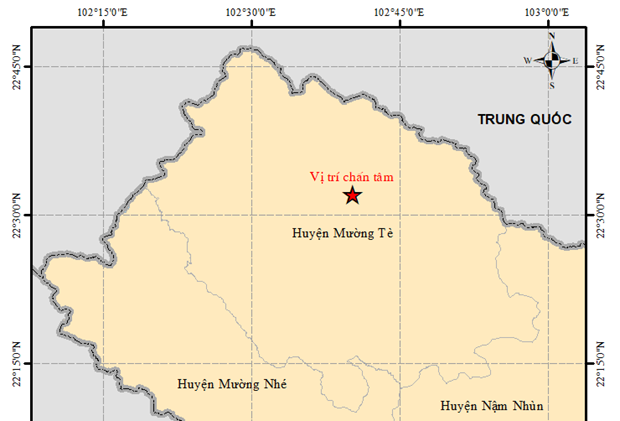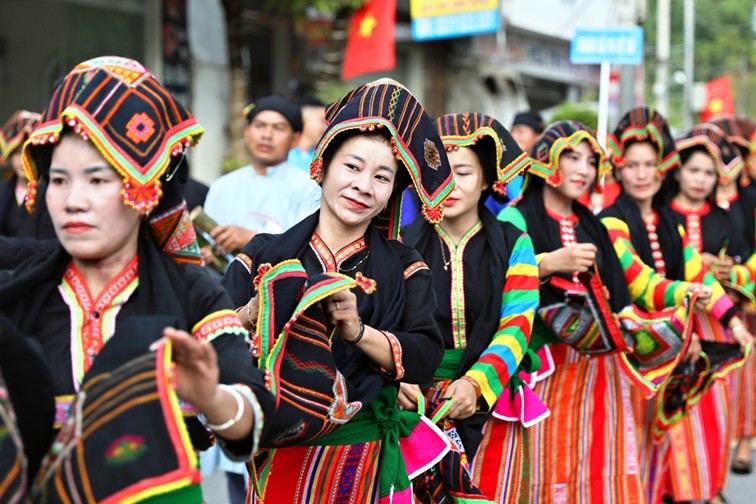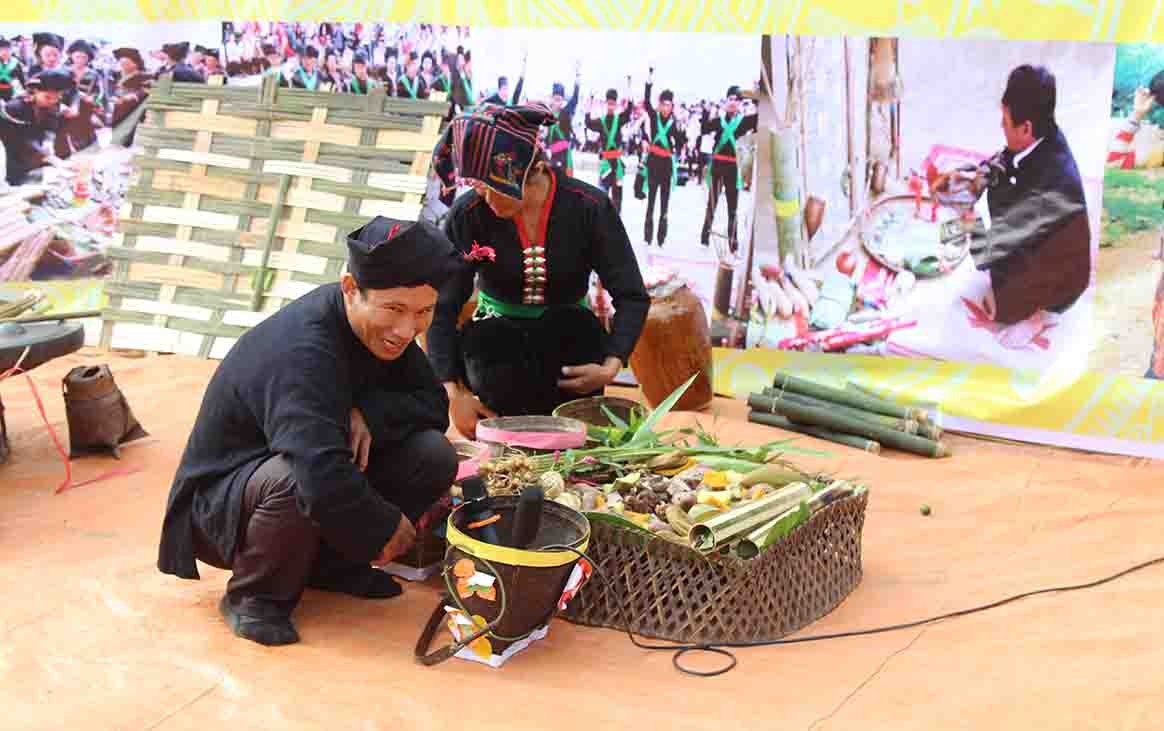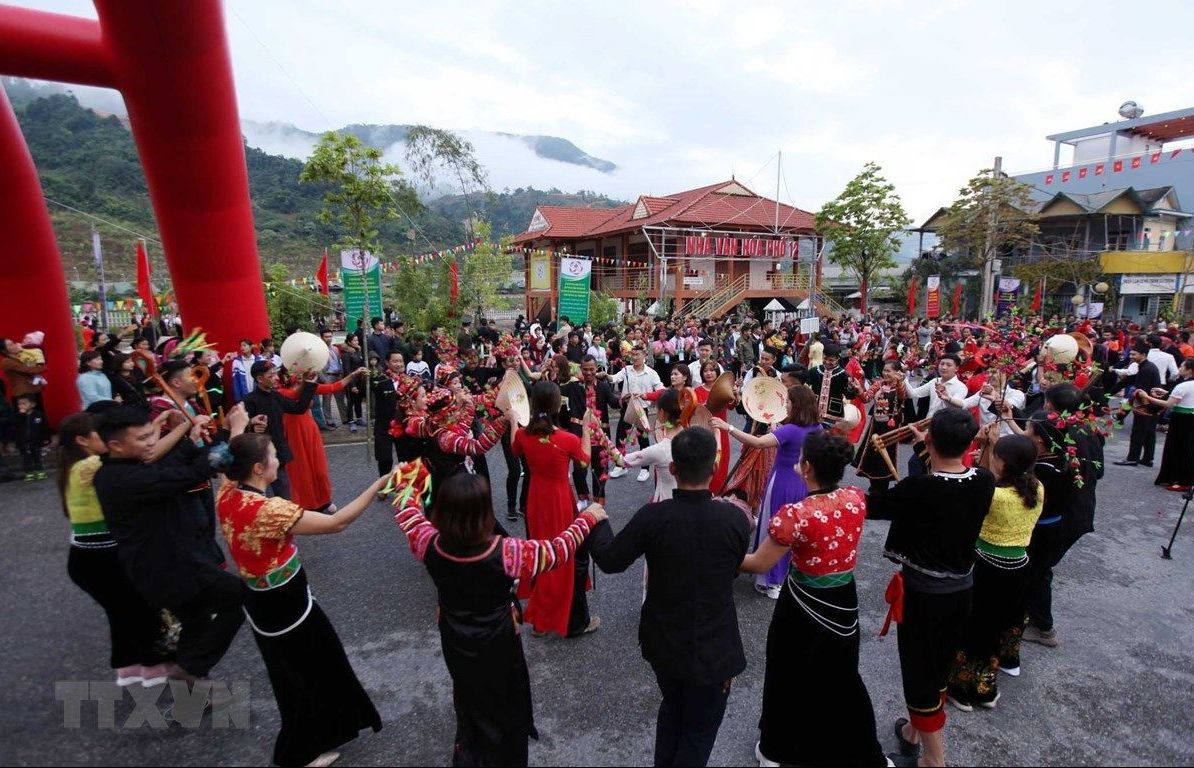
Cultural beauty of the Cong ethnic people amidst immense fog and clouds
Latest
 |
| Traditional costumes are the beauty and identity of the Cong ethnic people. (Photo: Tran Cong Dat) |
Unique identity in cuisine and costumes
The daily meal of the Cong ethnic group is mainly plain rice or sticky rice, along with meat and vegetables like other ethnic groups in the area. In addition, life is closely linked to nature, the dishes of the Cong ethnic group also come from nature. On holidays and Tet (Lunar New Year), rice offerings to ancestors must be fully displayed with dishes including pork meat, sticky rice, whole chicken, corn cakes and wine.
According to artisan Ly Thi Giong in Nam Khao commune, Muong Te district, Lai Chau province, corn cakes, tapioca cakes, sticky rice pan cakes, crab dishes stuffed with corn, dried fish, dried meat are typical dishes of the Cong ethnic people, especially during festivities. Everyone from the Cong people community knows how to make these types of cakes and invites shamans to worship on occasions of fiesta. In addition, the pig blood soup (Cha Kha Cha Vang) is also a popular dish of the Cong people. Cooked from pig's blood with forest herbal leaves and Glinus herniarioides bitter herbs, this dish is often used to treat stomach ailments or eaten to relieve a stomach ache.
Rock terrestrial crabs (Gecarcoidea lalandii) are also prepared and cooked quite expressly by the Cong people. Due to the concept that crabs are animals that protect crops, crabs must be caught from a clear stream, washed, split in half, removed of all the flesh, then stuffed with cornmeal and then reassembled into the same crab shape, then cooked and displayed. onto the tray. In the 8th month of the lunar calendar, during the festival of offering new rice, the Cong people often tie crabs on hunting and gathering tools so that the shaman can make offerings to spiritualize the tools.
Traditional costumes are also the beauty and identity of the Cong ethnic people. Men wear black and indigo suits, the buttons are tied with fabric knots. Women are more sophisticated with combined make-up and decorative costumes. Unmarried women tie their hair in a bun at the back, while married women tie their hair in a bun on top of their head. On both sides of the braide are symmetrical studded with silver coins.
The headscarf of Cong women is the Pieu scarf similar to that of the Black Thai people. They often use silver or gold jewelry to enhance their feminine beauty and protect their health. Cong women wear two types of blouses. A long type includes alternating blue, red, yellow, and white patches combined with unique embroidered patterns at the hem of the shirt. A type of black-stitched arm, a shirt with a slit at the chest, buttoned along the hem, decorated with silver buttons and colored threads. The Cong ethnic people wear blouses combined with floral dresses or black dresses with ancient patterns.
In Nam Khao commune, the girls here are proud that every house has a Bem – a tight-lid basket. This is a mother's dowry basket for her daughter containing fabric, clothes and jewelry. Bem is always placed under the altar and never moved. Using the good weaving techniques of the Cong people, Bem does not rot or become moldy over time, on contrary it is always solidly thick and fresh.
Unique cultural ethnic features
In addition to the New Year festival of offering new rice, the Cong people have many other special celebrations. During the village worshiping ceremony, held in the third lunar month, before the sowing season, the village makes a gate and places a taboo sign which means no one is allowed to enter the hamlet. The offerings include fish and crabs, praying for birds and animals not to damage them, and planting a few palanquins to pray for abundant rice crops and green trees.
When worshiping "forest ghosts" to smoke, the Cong people often take pipe tobacco and put it on leaves and then put it on a rock, after offering it, then take a bath. According to the beliefs of the Cong people, "forest ghosts" are the strongest ghosts that harm people. When invited to smoke, the forest ghosts are too happy to harm people. In the past, anyone in the house who was sick would also be treated with worshipping the forest ghosts. For a certain disease, a certain corresponding animal would be assigned to that disease.
The Corn Festival is held at late May, early June of the lunar calendar, when the corn season has been harvested. Corn has been the main food crop of the Cong people for hundreds of years, so the main offerings during the Corn Festival are mostly made from corn.
In the past, the Cong people had the praxis to keep the groom staying in his parents-in-law house for 8-12 years to take care of the wife's parents as a way to show gratitude for their birth giving and nurturing their daughters. Nowadays, it has been reduced to 2-3 years, and in many cases, there is no longer the praxis of the groom staying in parents-in-laws house. The wedding is held in the off-season, around November and December of the lunar calendar. The bride's parents give her a dowry including: blankets, mattresses, clothes, knives, hoes, spades, a pig, and a hen.
 |
| In addition to the festival of offering new rice, the Cong people have many other special celebrations. (Photo: Lai Chau Newspaper) |
The Cong people especially attach great importance to the ritual part, namely Reasoning. Before sending their daughter off to her husband's house, the bride's family will make amends with the most solemn and sacred ritual. The main meaning of Reasoning at the bride's family is to "cut off" the girl’s pneuma from the bride's family's altar (i.e. the girl no longer belongs to the ancestral or family altar). After welcoming the daughter-in-law home, the groom's family also has to conduct a ritual to "import" the bride’s pneuma into the family altar, the groom's ancestors.
Born from the forest, raised from the ravine, the Cong ethnic of Nam Khao commune, Muong Te district, have a distinguishing cultural treasure, with the richness of the colors of the mountains, forests, trees, flowers, and birds. They borrow lyrics and singing to relieve the fatigue of work, to share their care and affection for each other, and to express their feelings to the people they love. Combined with Cong folk songs are the folk dances such as Py Luym dance, round ring dance, to integrate the members with the community, between members with each other, thereby creating a marvelous attraction.
Through the historical process, the Cong ethnic people (Muong Te, Lai Chau) have been promoting the values of national identity to "integrate without being dissolved", contributing to promoting the economy and society. Currently, 100% of households have arable land and receive support from the State for poverty alleviation. They are supported with vocational training in career of weaving rattan, bamboo, and knitting skills for export; trade ethnically specific goods such as local specialty food and traditional medicine, thereby shortening the gap with other ethnic groups.











